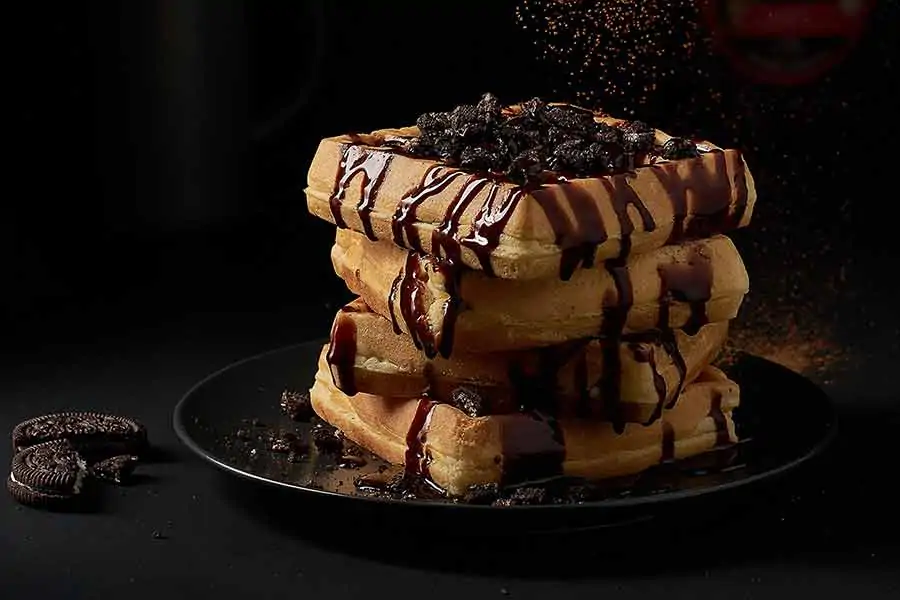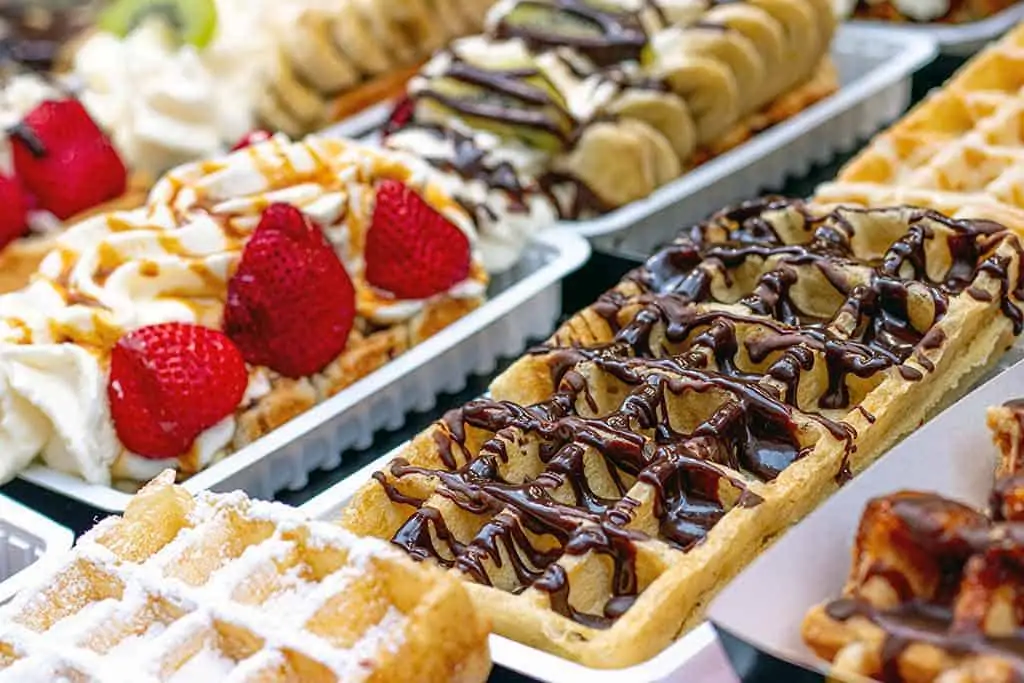Author: Tosh Lubek Published: 25th March 2021
KitchenAcorns.com is supported by its readers. Please assume links on this site are affiliate links or ads, and that I get commissions for purchases made through these links. As an Amazon Associate, I earn from qualifying purchases. Thank you if you use any of the links.
There are many different types of waffles, but in America, the two best-known waffle types are the regular kind and the Belgian waffle. But what makes Belgian waffles different from regular waffles? Let me give you a brief explanation.
Belgian waffles should be rectangular while regular waffles can be rectangular or round. But what truly separates the two types of waffles is size. Belgian waffles are larger, about 1½” thick, and have deeper pockets. Compared to regular waffles, they are crispier on the outside but lighter on the inside, due to yeast being used instead of baking powder.
Although Belgian waffles and regular waffles are similar the Belgian waffle is a relative newcomer to America. It was only introduced to the U.S. in the 1960s and based on a simplified Brussels Waffle recipe.
Is it Belgian or Belgium waffles?
What a good question.
Belgium is a multinational country in the northwest of Europe, which has a population of about 11.5 million people. Ethnically the population is mostly Dutch-speaking (40%) and French-speaking (60%). This brings us to the word, Belgian.
Belgian refers to someone or something from or of the Kingdom of Belgium.
So, when we’re talking about those beautifully crisp yet light and fluffy treats the correct term to use is Belgian Waffles.
Now that we’ve sorted out what we’re talking about let’s get into the details of what Belgian waffles are and what makes Belgian waffles different.
What is a Belgian waffle?

Waffles are not only popular in North America, but they’re also popular around the world. As you might expect, with global popularity there are bound to be many different local types of waffles.
One country, Belgium, boasts the greatest number of types per head of population, with at least a dozen local variations. Not bad for a country of only eleven and a half million people.
But if there are at least a dozen types of waffles from Belgium, what do we mean by a Belgian waffle? If they all come from Belgium, surely, they’re all Belgian waffles.
That’s true. But what Americans refer to as a Belgian waffle is really a simplified version of the Brussels waffle. As the name implies, it originates from the city of Brussels, the capital of Belgium.
The Brussels waffle traditionally uses egg whites and/or yeast as the leavening in the batter. Obviously, whisking egg whites and yeast in your baking can lengthen the preparation time. But the recipe can be simplified by substituting baking soda for the egg whites and yeast. This simple change transforms the Brussels waffle into a quick-to-make breakfast treat.
In Belgium, Brussels waffles are more like street food than a breakfast meal. Waffle stalls and trucks on the streets selling fresh “gaufres chaudes”, which is French for hot waffles.
Belgian waffle vs American waffle
Belgian waffles should be rectangular with defined edges, while regular waffles can be rectangular or round. But what truly separates the two types of waffle is their size. Belgian waffles are larger, being about 1½” thick, and having deeper pockets to catch and hold syrup and toppings. They are about 4” wide and up to 7” tall.
Compared to regular waffles, Belgian waffles are crispier on the outside but much lighter and fluffier on the inside.
Belgian waffle makers
If you’re looking for a Belgian waffle maker, you’ll undoubtedly see waffle makers that are round. Round is OK, but a traditional Belgian waffle, or Brussels waffle, is rectangular, large, and deep.
So, if you want to stick a little closer to tradition, look for a rectangular Belgian waffle iron. It should also be much deeper than the regular kind, at around 1½”. This means the little pyramid shapes in the grids will produce waffles with much deeper pockets. That’s more opportunity to catch and hold sweet sticky syrup and sauces.
First known Brussels waffle recipe
The name ‘Brussels waffles’ has been documented to around 1842-1843.
Research has shown that a Brussels baker, Florian Dacher, was advertising a specialty of his, Grosses Gaufres de Bruxelles, or Thick Brussels Waffles.
A little over thirty years later, Phillippe Cauderlier, a friend of Dacher, published the first know recipe for Brussels waffles in his cookbook La pâtisserie et les confitures in 1874.
The waffle dough was made from:
Butter, egg yolks, egg whites whisked firm, flour, milk, salt, and seasoning.
Although there’s no mention of yeast, the whisked egg whites were the leavening in the recipe and gave the rise to the dough (or batter). If you make your own waffle batter from scratch, you can see that the ingredients are pretty much the same as you’d use today.
Light, Fluffy, and flavorsome waffles
If you don’t mind going to a little more effort, use a Belgian waffle recipe that uses beaten egg whites and yeast as leavening. Changing to these traditional leaving agents helps to create waffles that are crispy on the outside but light and fluffy on the inside. You’ll also be changing to a more interesting flavor in the process.
Talking of enhancing the flavor, consider using melted butter instead of oil. Use the same amount of melted butter as the volume of oil in your recipe. Most recipes call for ½ cup of oil, therefore you’d need ½ cup of melted butter.
Since most vegetable oils tend to be bland, using butter awakens the rich taste and aroma that only butter can bring to your waffle making. I’m sure you’ll love it.
How the Belgian waffle came to America
Although it was the Dutch who brought the regular waffle to America, it was the Belgians who introduced Americans to the Belgian waffle. However, it took two attempts before the Belgian waffle took off.
Americans had their first opportunity to try Belgian waffles when Walter Cleyman from Belgium baked and sold Brussels waffles at the 1962 Seattle World’s Fair.
According to the Spokane Daily Chronicle, the waffles were soft and twice as thick as every-day U.S. waffles and served with whipped cream and strawberries. Although at the time it was considered “uncultured” to add syrup as a further topping.
Although popular, it wasn’t until two years later that the idea really caught on. This time it was at the 1964 New York World’s Fair. Another Belgian, Maurice Vermersch, simplified the recipe, changed the name, and served the waffles with whipped cream and strawberries. Finally, Belgian waffles were an American hit.
Conclusion: Brussels Belgian waffle vs Liege Belgian waffle
When you bite into a Brussels waffle, the outside is golden brown and crispy, but the inside is airy, fluffy, and light. When it comes to taste, whatever topping you might add, the Belgian waffle is neither over sweet nor under sweet. As Goldilocks might say, it’s just right.
But hold up.
I really need to mention there’s another contender for the title of Belgian waffle, the Liege waffle.
As I’ve explained, Brussels waffles are light and airy since they are made from a whisked egg white and/or yeast leavened batter. In shape they are rectangular, with defined edges, and are quite deep at about 1½”.
Liege waffles are quite different in both shape and texture. They are made from a much heavier batter that more reminiscent of brioche yeast dough. They don’t have defined edges and tend to be a long oval.
The other distinguishing feature of Liege waffles, and the sweetest of all, is that they include pear sugar throughout their volume.
Pearl sugar is little irregular stones of sugar that become crunch sugar bites in the cooked waffle.
You might also like…
Tosh learned how to cook while watching his Polish Mom at home. He also worked in a family-owned restaurant while a student and learned much from the chefs. Cooking has always interested him, especially the hearty Polish recipes he learned from his mother. He has helped create and appeared on cookery shows on radio stations in Scotland.
Recent Posts
This family pancake recipe will make about thirty-six pancakes that have a thickness of about 3/8th to half an inch and a diameter of about 4 inches. In my family, I would often prepare a batch of...
If you want to know a lot more about waffles but don’t have the time to read through loads of articles, you’re in the right place. I’ve collected together 25 of the most often asked...





